国際セミナー“Human Nature Interactions of the Riverine Societies in Sarawak:
A Transdisciplinary Approach”
International Seminar on “Human Nature Interactions of the Riverine Societies in Sarawak: A Transdisciplinary Approach”
Date: December 4, 2014
Venue: Conference Room of Faculty of Social Sciences Universiti Malaysia Sarawak
Organizers:
Center for Southeast Asian Studies, Kyoto University
Faculty of Social Sciences, University of Sarawak Malaysia
Sarawak Forestry Corporation
2014年12月4日(木)に、マレーシア・サラワク大学(UNIMAS)の社会科学部(Faculty of Social Sciences)会議室において、本プロジェクトの成果報告とその現地還元を目的としたセミナー「Human Nature Interactions of the Riverine Societies in Sarawak: A Transdisciplinary Approach」を開催しました。
今回のセミナーでは、UNIMASのPoline Bala氏、Elena Chai氏、サラワク森林公社(Sarawak Forestry Corporation:SFC)のBibian Diway氏らの協力のもと、UNIMAS社会科学部およびSFCとの共催という形で実現したものです。
午前中は、石川代表のオープニング・スピーチを含む5件の発表、午後は4件の発表と総合討論という構成で、2012年に開催した中間報告にあたるセミナーと比べると、今回のセミナーは比較的こじんまりとしたものでしたが、それでも70名を超える参加者を得て、盛会に終えることができました。
今回も、調査にご協力いただいたSarawak Planted Forest社、Grand Perfect社、KeresaOil Palm Plantation社、Zedtee社のほか、調査許可取得でお世話になったサラワク州企画庁(State Planning Unit: SPU)やサラワク森林局(Forest Department Sarawak)からも関係者にご参加いただきました。各発表の質疑応答や総合討論の場だけでなく、コーヒー・ブレイクの時間も含め、セミナー全体を通して多くの有益な質問・コメントを得られたことに感謝しています。次頁以降に、当日のプログラムと各発表の要旨を掲載します。
なお、UNIMASのElena Chai氏には、各種ロジスティックスの面で大変お世話になり、当日は午前中の司会もしていただきました。また、Elena氏および社会科学部には本ニューズレター掲載用の写真もご提供いただきました。改めてお礼申し上げます。
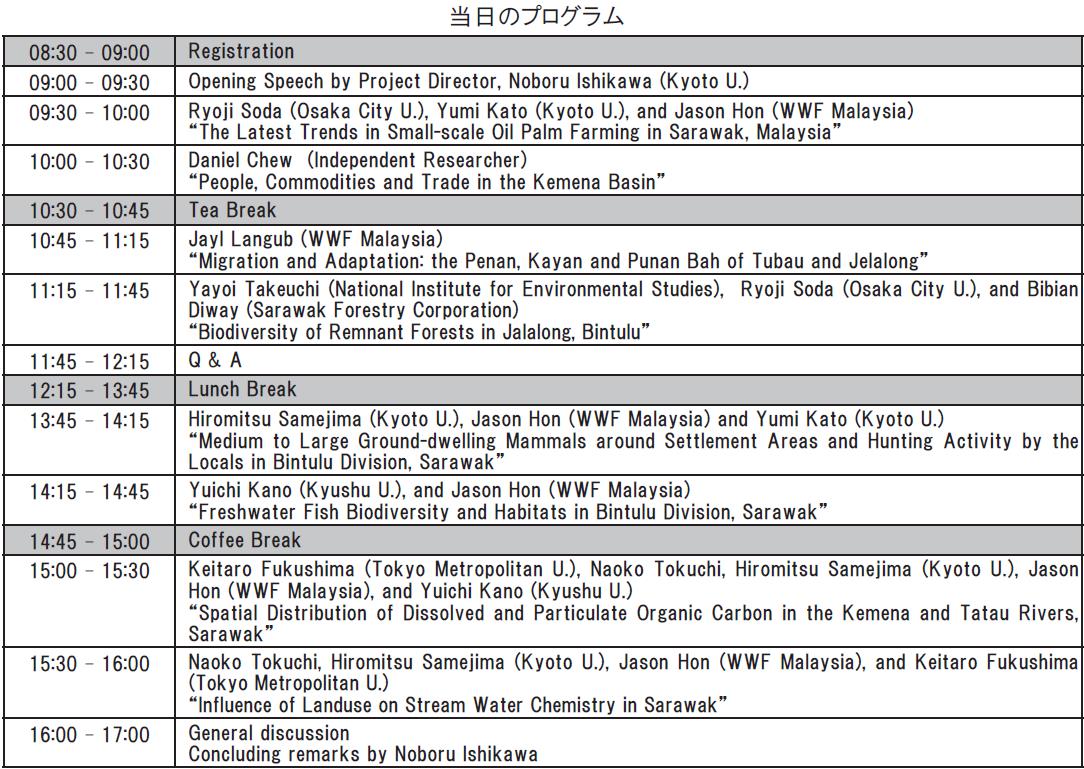
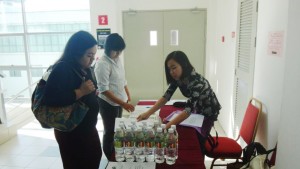
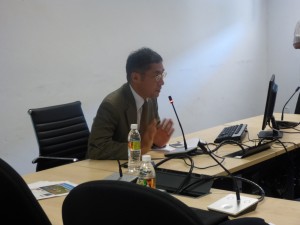 The distinction between social sciences and natural sciences continues to make communication for researchers in these two areas an uneasy task. The transformative research on anthropogenic tropics, however, is too important to be addressed in any way other than through a trans-disciplinary approach. We can no longer afford to be in isolation and separation when investigating relations between natural and social systems and the articulation between the two. The seminar introduces our challenge to conventional anthropocentric perspectives in the social sciences by examining connections and changing relations between human and nature.
The distinction between social sciences and natural sciences continues to make communication for researchers in these two areas an uneasy task. The transformative research on anthropogenic tropics, however, is too important to be addressed in any way other than through a trans-disciplinary approach. We can no longer afford to be in isolation and separation when investigating relations between natural and social systems and the articulation between the two. The seminar introduces our challenge to conventional anthropocentric perspectives in the social sciences by examining connections and changing relations between human and nature.
The project leader first presents an overview of five-year collaborative research (2010-2014) on the human-nature interactions in the riverine societies of Sarawak, Malaysia. An innovative multi-sited research has been conducted in the Kemena and the Tatau catchment basins in Bintulu District, by a team of natural and social scientists in order to examine the emerging dynamics of landscapes of Sarawak. The riverine societies connecting inland and coast were strategically chosen to examine the characteristics of human and non-human communities as well as the interactions between the two.
The research team represents a wide array of fields and approaches that include anthropology, human geography, history, rural and macro economy, plant, animal and ecosystem ecology, agronomy, hydrology, and life cycle assessment. Through the application of trans-disciplinary expertise and collaboration, the team focuses on multi-dimensional aspects of human-nature interactions in a mixed landscape that consists of primary and secondary forests, swidden fields and plantations.
The fieldwork is conducted in tropical forests (primary, secondary, and logged) and planted forests in equatorial Southeast Asia, one of the most economically dramatic zones of Asia. Although the question is contextualized and addressed in a specific environ, it has regional as well as global relevance. This learning is necessary if we want to envision better human-nature relationships in the tropics.
Focusing on a riverine society in Sarawak, Malaysia, the researchers look into multi-cultural communities and mixed landscapes in the catchments connecting coastal and inland areas. The research team investigates a critical balance between the geosphere, biosphere, and local communities. The research is based on collaboration with multiple local stakeholders, including governmental agencies, academic institutions, and the private sector.
The ecological research team, in collaboration with social scientists, analyzes the eco-systems of natural forests and planted forests of oil palm and acacia in the catchments, where heterogeneous landscapes and multiple modes of land-use and production are observable. Anthropologists look at the changes in hunting and gathering practices among locals. Animal ecologists map the spatial structure of biodiversity of large mammals through camera trap research, while plant ecologists look into sustainable forest management of a logging concession area. While ecosystem ecologists examine the flows of nitrogen and particulate organic matter and fish ecologists look into biodiversity under water, hydrologists examine the water cycles in and across river catchments. The socio-cultural research team focuses on the transformation from environment-dependent hunting, gathering, and swidden agriculture to off-farm wage labor, rubber-tapping, and small-scale oil palm cultivation and to the strategic combination of these activities with conventional subsistence. The project also works on the riverine society and beyond, paying particular attention to spatially extended kin networks, flows of remittances, and the development of traditional forest product commodity chains based on the expansion of road networks. What we see in the transformation of one part of Southeast Asia are features common among equatorial zones across the world. Tropical Southeast Asia serves as an important site for investigation where a multidisciplinary analysis offers alternative models and scenarios toward sustainability of both local environments and societies.
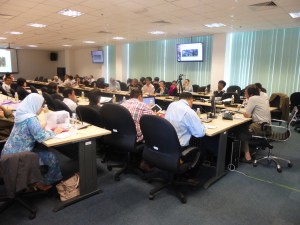
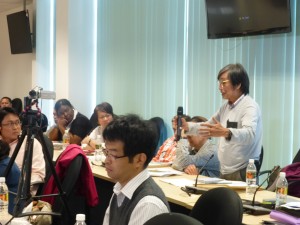 The Penan were the first to move into the Jelalong in the early 1800s, followed by the Kayan into Tubau and then the Punan Bah in the lower Jelalong not far upriver from the trading center located at the confluence of Jelalong and Tubau. The Penan briefly led a nomadic life in the Merurong, in upper Jelalong before establishing (initially) three settlements, one at Kebulu and two along the Jelalong and adopted swidden farming like their Kayan and Punan Bah neighbors downriver. Tubau was an important upriver trading center and, through historical time, played quite important role in shaping the social and economic life of the three ethnic communities under discussion.
The Penan were the first to move into the Jelalong in the early 1800s, followed by the Kayan into Tubau and then the Punan Bah in the lower Jelalong not far upriver from the trading center located at the confluence of Jelalong and Tubau. The Penan briefly led a nomadic life in the Merurong, in upper Jelalong before establishing (initially) three settlements, one at Kebulu and two along the Jelalong and adopted swidden farming like their Kayan and Punan Bah neighbors downriver. Tubau was an important upriver trading center and, through historical time, played quite important role in shaping the social and economic life of the three ethnic communities under discussion.
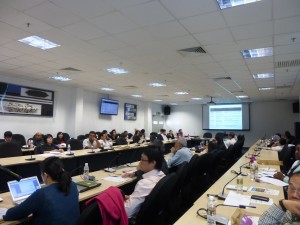
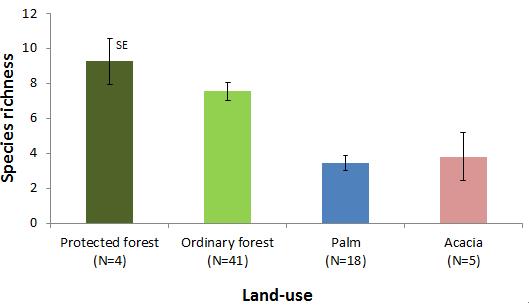
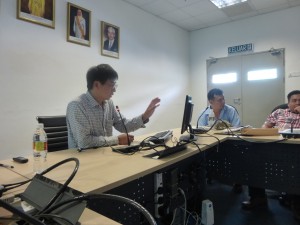
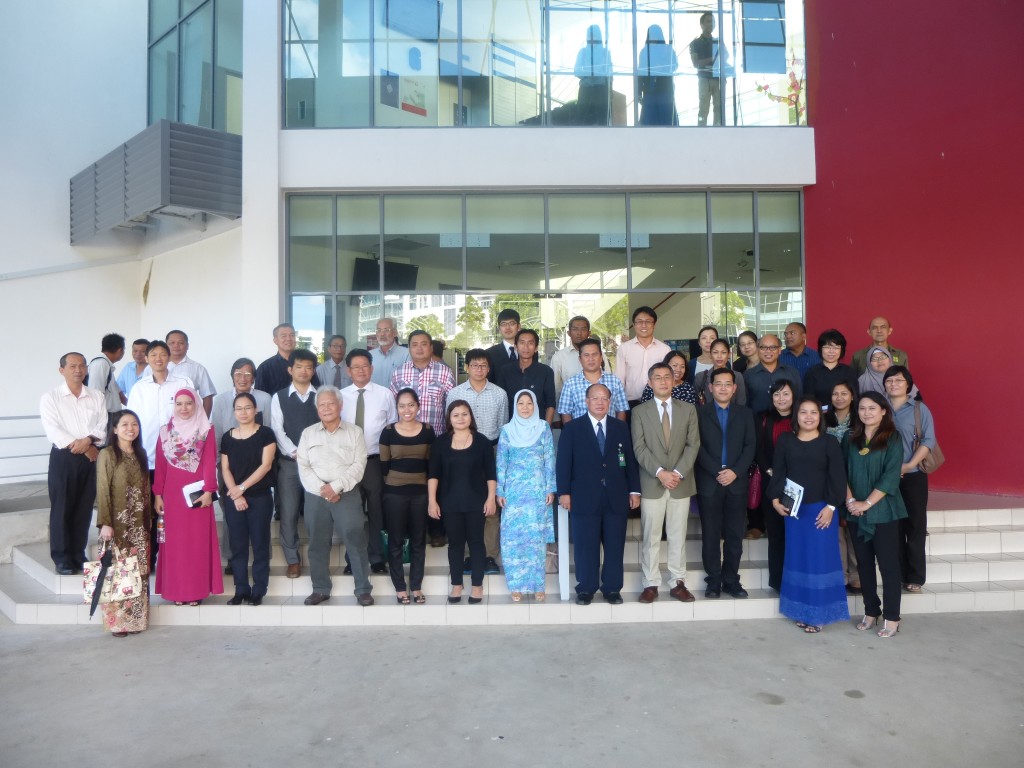
Date: December 4, 2014
Venue: Conference Room of Faculty of Social Sciences Universiti Malaysia Sarawak
Organizers:
Center for Southeast Asian Studies, Kyoto University
Faculty of Social Sciences, University of Sarawak Malaysia
Sarawak Forestry Corporation
2014年12月4日(木)に、マレーシア・サラワク大学(UNIMAS)の社会科学部(Faculty of Social Sciences)会議室において、本プロジェクトの成果報告とその現地還元を目的としたセミナー「Human Nature Interactions of the Riverine Societies in Sarawak: A Transdisciplinary Approach」を開催しました。
今回のセミナーでは、UNIMASのPoline Bala氏、Elena Chai氏、サラワク森林公社(Sarawak Forestry Corporation:SFC)のBibian Diway氏らの協力のもと、UNIMAS社会科学部およびSFCとの共催という形で実現したものです。
午前中は、石川代表のオープニング・スピーチを含む5件の発表、午後は4件の発表と総合討論という構成で、2012年に開催した中間報告にあたるセミナーと比べると、今回のセミナーは比較的こじんまりとしたものでしたが、それでも70名を超える参加者を得て、盛会に終えることができました。
今回も、調査にご協力いただいたSarawak Planted Forest社、Grand Perfect社、KeresaOil Palm Plantation社、Zedtee社のほか、調査許可取得でお世話になったサラワク州企画庁(State Planning Unit: SPU)やサラワク森林局(Forest Department Sarawak)からも関係者にご参加いただきました。各発表の質疑応答や総合討論の場だけでなく、コーヒー・ブレイクの時間も含め、セミナー全体を通して多くの有益な質問・コメントを得られたことに感謝しています。次頁以降に、当日のプログラムと各発表の要旨を掲載します。
なお、UNIMASのElena Chai氏には、各種ロジスティックスの面で大変お世話になり、当日は午前中の司会もしていただきました。また、Elena氏および社会科学部には本ニューズレター掲載用の写真もご提供いただきました。改めてお礼申し上げます。


イベント開催当日の参加受付の模様
Human-Nature Interactions of the Riverine Societies in Sarawak, Malaysia
Noboru Ishikawa (Kyoto University)
 The distinction between social sciences and natural sciences continues to make communication for researchers in these two areas an uneasy task. The transformative research on anthropogenic tropics, however, is too important to be addressed in any way other than through a trans-disciplinary approach. We can no longer afford to be in isolation and separation when investigating relations between natural and social systems and the articulation between the two. The seminar introduces our challenge to conventional anthropocentric perspectives in the social sciences by examining connections and changing relations between human and nature.
The distinction between social sciences and natural sciences continues to make communication for researchers in these two areas an uneasy task. The transformative research on anthropogenic tropics, however, is too important to be addressed in any way other than through a trans-disciplinary approach. We can no longer afford to be in isolation and separation when investigating relations between natural and social systems and the articulation between the two. The seminar introduces our challenge to conventional anthropocentric perspectives in the social sciences by examining connections and changing relations between human and nature.The project leader first presents an overview of five-year collaborative research (2010-2014) on the human-nature interactions in the riverine societies of Sarawak, Malaysia. An innovative multi-sited research has been conducted in the Kemena and the Tatau catchment basins in Bintulu District, by a team of natural and social scientists in order to examine the emerging dynamics of landscapes of Sarawak. The riverine societies connecting inland and coast were strategically chosen to examine the characteristics of human and non-human communities as well as the interactions between the two.
The research team represents a wide array of fields and approaches that include anthropology, human geography, history, rural and macro economy, plant, animal and ecosystem ecology, agronomy, hydrology, and life cycle assessment. Through the application of trans-disciplinary expertise and collaboration, the team focuses on multi-dimensional aspects of human-nature interactions in a mixed landscape that consists of primary and secondary forests, swidden fields and plantations.
The fieldwork is conducted in tropical forests (primary, secondary, and logged) and planted forests in equatorial Southeast Asia, one of the most economically dramatic zones of Asia. Although the question is contextualized and addressed in a specific environ, it has regional as well as global relevance. This learning is necessary if we want to envision better human-nature relationships in the tropics.
Focusing on a riverine society in Sarawak, Malaysia, the researchers look into multi-cultural communities and mixed landscapes in the catchments connecting coastal and inland areas. The research team investigates a critical balance between the geosphere, biosphere, and local communities. The research is based on collaboration with multiple local stakeholders, including governmental agencies, academic institutions, and the private sector.
The ecological research team, in collaboration with social scientists, analyzes the eco-systems of natural forests and planted forests of oil palm and acacia in the catchments, where heterogeneous landscapes and multiple modes of land-use and production are observable. Anthropologists look at the changes in hunting and gathering practices among locals. Animal ecologists map the spatial structure of biodiversity of large mammals through camera trap research, while plant ecologists look into sustainable forest management of a logging concession area. While ecosystem ecologists examine the flows of nitrogen and particulate organic matter and fish ecologists look into biodiversity under water, hydrologists examine the water cycles in and across river catchments. The socio-cultural research team focuses on the transformation from environment-dependent hunting, gathering, and swidden agriculture to off-farm wage labor, rubber-tapping, and small-scale oil palm cultivation and to the strategic combination of these activities with conventional subsistence. The project also works on the riverine society and beyond, paying particular attention to spatially extended kin networks, flows of remittances, and the development of traditional forest product commodity chains based on the expansion of road networks. What we see in the transformation of one part of Southeast Asia are features common among equatorial zones across the world. Tropical Southeast Asia serves as an important site for investigation where a multidisciplinary analysis offers alternative models and scenarios toward sustainability of both local environments and societies.
The Latest Trends in Small-scale Oil Palm Farming in Sarawak, Malaysia
Ryoji Soda (Osaka City University)
Yumi Kato (Kyoto University)
Jason Hon (WWF Malaysia)
In the last decade rural Sarawak experienced a boom of small-scale oil palm farming. In recent years those who have wage-jobs in the city have become involved in oil palm farming in their home village as ‘weekend farmers.’ As a new type of oil palm development, joint-ventures between villagers and outsiders have also emerged in the last few years. In these trends, some well-off people began to use Indonesian workers to take care of their farms.
Although the total area of oil palm smallholding is rapidly increasing, most of oil palm farms in rural villages are patchily distributed in a small scale with less than one hectare. From the perspective of plantation management and efficient land use practices, the small-scale oil palm farming in Sarawak appears to be inefficient, even irrational. The villagers’ land-use patterns, however, conform to their traditional land tenure customs, resulting in a mosaic of patchy vegetation landscape with paddy fields, rubber gardens, young and old fallow forests, and oil palm farms.
Even advanced oil palm villages usually have a certain amount of land left as fallow forests, and villagers consider it easy to return to slash-and-burn agriculture and rubber tapping. As long as the mosaic-like village landscape is maintained, they can secure their opportunistic and diverse land-use practices to survive any sharp drop in oil palm prices and resort back to minimal standard of living. In this sense, it is important to find out a way of achieving healthy balance between villagers and other oil palm actors such as outsider developers and large-scale plantations.
People, Commodities and Trade in the Kemena and Tatau Basins
Daniel Chew (Independent Researcher)
River basins are geophysical features in Sarawak with inter-connected histories, cultures and environment. The Kemena and Tatau rivers, with their natural catchments and watersheds are a macro region where the interstices of man and nature meet. The two defining characteristics of the Kemena and Tatau basins are natural resources and the diversity of people. This paper examines the role of three principal groups of actors in this man-environment nexus, a small band of officials of the Brooke Raj (1841-1941), Chinese traders and indigenous communities, with emphasis on the Chinese.
Relying on written sources, mainly the Sarawak Gazette and fieldwork interviews, I look at the inter-connected processes of interactions between people, commodities and trade. Brooke rule in the Kemena and Tatau basins, starting around 1861, depended on trade for the control of people and territoriality. Chinese traders and indigenous groups were the drivers in harnessing and trading in the jungle commodities like gutta, rattan and timber. The resources of the basins attracted indigenous migration from other river catchments which in turn contributed to the plurality of ethnic groups along the Kemena and Tatau rivers. Chinese traders were encouraged to come with the opportunities for trade. The conduct of trade during this 19th century period, which carried well over to the mid-20th century, was predicated upon economic exchange, the exchange of value, of procured commodities in the Kemena and Tatau basins for goods from outside Sarawak. Over time, with the procurement and trade in jungle products, the ethnoscape of the two basins was transformed, with a Chinese trading class established in Bintulu, Tatau, Tubau and other outposts. The resources of the riverine hinterland, through trade, contributed to the growth of the downriver coastal centres like Bintulu and further down the coast to Kuching, and supported the fledging Brooke Raj. Through commodity chains driven by the search for resources, the Kemena and Tatau catchments were linked up with the maritime zone of coastal centres which in turned connected with regional ports across the seas. What Bintulu Division is today has its antecedents in the man-nature interstices outlined above.

Migration and Adaptation: the Penan,Kayan and Punan Bah of Tubau and Jelalong
Jayl Langub (WWF Malaysia)
 The Penan were the first to move into the Jelalong in the early 1800s, followed by the Kayan into Tubau and then the Punan Bah in the lower Jelalong not far upriver from the trading center located at the confluence of Jelalong and Tubau. The Penan briefly led a nomadic life in the Merurong, in upper Jelalong before establishing (initially) three settlements, one at Kebulu and two along the Jelalong and adopted swidden farming like their Kayan and Punan Bah neighbors downriver. Tubau was an important upriver trading center and, through historical time, played quite important role in shaping the social and economic life of the three ethnic communities under discussion.
The Penan were the first to move into the Jelalong in the early 1800s, followed by the Kayan into Tubau and then the Punan Bah in the lower Jelalong not far upriver from the trading center located at the confluence of Jelalong and Tubau. The Penan briefly led a nomadic life in the Merurong, in upper Jelalong before establishing (initially) three settlements, one at Kebulu and two along the Jelalong and adopted swidden farming like their Kayan and Punan Bah neighbors downriver. Tubau was an important upriver trading center and, through historical time, played quite important role in shaping the social and economic life of the three ethnic communities under discussion.
Biodiversity of Remnant Forests in Jalalong, Bintulu
Yayoi Takeuchi (National Institute for Environmental Studies)
Ryoji Soda (Osaka City University)
Bibian Diway (Sarawak Forestry Corporation)
This study aimed to investigate biodiversity conservation values of the remnant forests besides the indigenous villages in Sarawak. We conducted our survey in the five villages in Jelalong river-basin, Tubau, Sarawak, where the remnant forests still remain. Villagers used the forests for collecting forest-based materials such as jangle vegetables and rattans. The several forests were also used as water catchment areas. In those forests, we established 16 quadrates (50 x 50 m each) in eight forests and assessed tree species diversity. As a result, we found that the species diversity in the remnant forests was as high as that in a primary forest. All forests contained unique species and also held endangered species. Thus, those results suggested that conserving remnant forests would contribute to restore the regional biodiversity and also preserve ecosystem services for local community.

Medium to Large Ground-dwelling Mammals around Settlement Areas and Hunting Activity by the Locals in Bintulu Division, Sarawak
Hiromitsu Samejima (Kyoto University)
Jason Hon (WWF Malaysia)
Yumi Kato (Kyoto University)
Medium to large mammals are part of rich biodiversity of Borneo, but also important protein resource for the local communities. To understand the change of species composition and abundance of medium to large mammals following recent landscape transition in lowland Sarawak, we established 8 x 8 km plot around four settlement areas from upper stream to oil-palm plantation area in Bintulu Division (Ulu Anap, Jelalong, Lavang, and Sujan) and set an automatic digital camera with infrared sensor every two kilometers in each plot. We also interviewed hunting activities of all 14 villages in the four plots. As the result, although number of active hunters are adequate in each plot, abundance of major game species, wild boar, sambar deer and mousedeer are still abundant in the secondary forests of lowland area. Therefore, those forest are still supplying ecosystem service (as food resource) for the local communities. However, many rare and endangered species such as sun bear, pangolin and wild cat are abundant only in upstream logging concession. Therefore, sustainable management of the natural forest is important to maintain the rich biodiversity of Sarawak.
Freshwater Fish Biodiversity and Habitats in Bintulu Division, Sarawak
Yuichi Kano (Kyushu University)
Jason Hon (WWF Malaysia)
We conducted freshwater survey around Bintulu area in Sarawak, Malaysia. Totally 68 sites were surveyed quantitatively surveyed by electrofishing and 41 sites were surveyed qualitatively. We found 107 species in total, of which 29 species were still uncertain because of the lack of literatures and information. The 107 species consists of 10 orders where Cypriniformes (40 species), Perciformes (33 species) and Siluriformes (21 species) were major. As for family, 33 families were ascertained, while Cyprinidae (29 species) was the most major, followed by Gobiidae (10 species) and Bagridae (9 species).
The species richness is highest in protected forest (9.3 species), followed by ordinary forest (7.5 species), Acacia plantation (3.8 species) and palm plantation (3.4 species) (see the figure below). We will also show how the water quality indicators such as pH, EC, NH4, NO3 and SO4 affected the fish fauna.


Spatial Distribution of Dissolved and Particulate Organic Carbonin the Kemena and Tatau Rivers, Sarawak
Keitaro Fukushima (Tokyo Metropolitan University)
Naoko Tokuchi (Kyoto University)
Hiromitsu Samejima (Kyoto University)
Jason Hon (WWF Malaysia)
Yuichi Kano (Kyushu University)
River carries large quantities of carbon (C) from land to the ocean. Understanding C dynamics in the terrestrial and coastal ecosystems is significantly important for developing the strategy for controlling the carbon dioxide efflux, but the factors determining the concentrations of riverine carbon are still unknown, especially in the tropical areas. The main forms of this carbon are dissolved and particulate organic carbon (DOC and POC, respectively). We investigated the spatial distribution of DOC and POC or suspended sediment (SS) concentrations in the Kemena and Tatau rivers in the summer of 2011, 2012 and 2013. There is a large variation in the DOC and POC concentrations in both rivers, but the spatial pattern was different between them. DOC concentration did not vary among the sampling year, and largely depended on the distribution of peat swamp areas within the watershed. SS concentration varied temporally and spatially. Since organic C concentrations in SS were similar, there was a linear relationship between SS and POC concentrations except for the headwater streams, where organic matters such as fragmented leaf-litter input directly. The SS or POC concentrations had no clear relationship with the land-use which was determined by the past aerial photograph, but they seemed to be higher in the branch of river near the newly-created plantation. Our results suggest that DOC concentration is controlled naturally but the intensive plantation creation and resultant soil disturbance can cause.
Influence of Landuse on Stream Water Chemistry in Sarawak
Naoko Tokuchi (Kyoto University)
Hiromitsu Samejima (Kyoto University)
Jason Hon (WWF Malaysia)
Keitaro Fukushima (Tokyo Metropolitan University)
Recently, land-use has dramatically changed in Sarawak from natural forests to oil palm and acacia plantation etc. It causes the serious change in the environment; air, soil and water. Especially, the stream water is very important in this region, because there are many people live in longhouses along the rivers and use the water for daily life. However, the information of the influences of land-use change on the stream water is not enough in Sarawak. To clarify the influences of land-use change on the stream water chemistry, we have studied the Kemena (including Jelalong, Pandan and Binyo) and Tatau (including Anap) rivers since 2010. In this presentation we show the impact of forest management and discuss the stream water chemistry among the different land-uses; oil palm plantation, acacia plantation and the natural forest under sustainable forest management.
(文:祖田亮次・鮫島弘光、写真:祖田亮次・Elena Chai)


